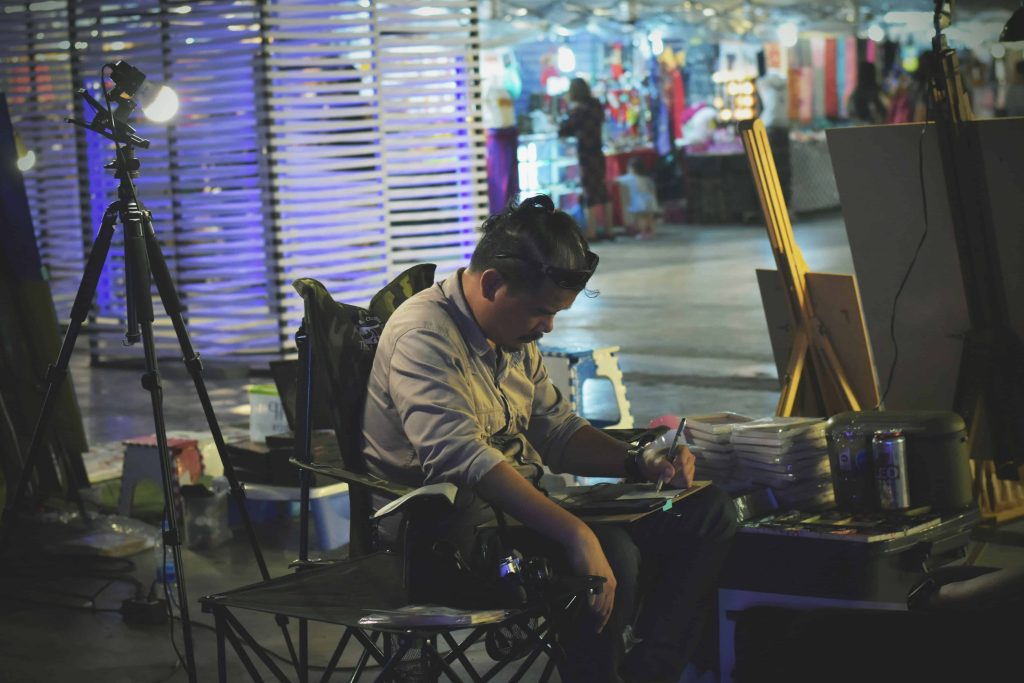
25 Sep Sustainable Art Practices for Contemporary Artists
How Contemporary Artists Are Leading the Charge in Sustainability
Sustainability has become a pivotal aspect of our lives, influencing everything from how we consume products to how industries operate. The art world is no exception. As environmental concerns intensify, artists have a unique platform to raise awareness and inspire change through their work. Sustainable art practices not only contribute to environmental preservation but also enrich the creative process, making it a crucial area for contemporary artists to explore.

The Why: Benefits of Sustainable Art Practices
Environmental Benefits
- Reduce Waste Going to Landfills: By utilizing materials that would otherwise be discarded, artists can significantly decrease the volume of waste contributing to landfill overflow.
- Minimize Pollution from Art Materials: Traditional art supplies often contain harmful chemicals that can pollute air and water. Sustainable practices focus on non-toxic, biodegradable, and eco-friendly alternatives.
- Conserve Resources: By opting for recycled or natural materials, artists help conserve the raw resources typically used in producing art supplies, reducing the overall environmental footprint.
Artistic Benefits
- Foster Creativity Through Using Unconventional Materials: Working with found objects or recycled materials challenges artists to think outside the box, leading to innovative and unique creations.
- Lead to New and Innovative Art Forms: Sustainable practices can inspire new genres and techniques in art, pushing the boundaries of traditional art forms.
- Add a Deeper Layer of Meaning to Artwork: Art created from sustainable practices often carries a message about environmental consciousness, adding depth and narrative to the work.

The How: Implementing Sustainable Practices
Sourcing Materials Sustainably
- Utilizing Recycled or Upcycled Materials: Look for materials that have been discarded and can be repurposed, such as scrap metal, old fabrics, and used paper.
- Finding Ethically Sourced and Natural Materials: Choose materials that are harvested in an environmentally friendly manner, ensuring minimal impact on ecosystems.
- Supporting Local and Sustainable Businesses for Supplies: Buying from local artisans and suppliers not only supports the community but also reduces the carbon footprint associated with transporting goods.
Minimizing Waste in the Studio
- Employing the “Reduce, Reuse, Recycle” Approach: Adopt a mindset of reducing the amount of new materials purchased, reusing existing materials, and recycling whenever possible.
- Practicing Proper Disposal of Hazardous Materials: Properly dispose of paints, solvents, and other hazardous materials to prevent environmental contamination.
- Considering the Longevity and Reusability of Artworks: Create artworks that are durable and can be repurposed or recycled, ensuring they don’t contribute to waste once they are no longer in use.

Beyond the Studio: Sustainability in Promotion and Display
Utilizing Digital Tools for Promotion and Marketing
Leverage digital platforms for marketing and selling artwork, reducing the need for physical promotional materials. Online galleries, social media, and virtual exhibitions are effective and eco-friendly ways to reach a wider audience.
Considering Eco-Friendly Packaging for Artwork
When shipping artwork, opt for sustainable packaging materials such as recycled cardboard, biodegradable packing peanuts, and reusable containers. This minimizes the environmental impact of delivering art to buyers.
Collaborating with Sustainable Galleries and Art Fairs
Partner with galleries and art fairs that prioritize sustainability. These venues often have policies in place to reduce waste and promote eco-friendly practices, aligning with your commitment to the environment.

Conclusion
Sustainable art practices are not only beneficial for the environment but also enhance the creative process and add meaningful dimensions to the artwork. By sourcing materials sustainably, minimizing studio waste, and embracing eco-friendly promotion and display methods, artists can make a significant positive impact. Embracing these practices is a step towards a more sustainable future, and contemporary artists have the power to lead the way. Let your art be a testament to your commitment to the planet, inspiring others to follow suit.
Key Takeaways
- Importance of Sustainability in Art
- Artists are using their work to promote environmental awareness and enhance creativity.
- Environmental Benefits
- Waste Reduction: Using discarded materials reduces landfill waste.
- Pollution Minimization: Eco-friendly materials prevent air and water pollution.
- Resource Conservation: Recycled and natural materials save raw resources.
- Artistic Benefits
- Enhanced Creativity: Unconventional materials inspire unique art.
- New Genres: Sustainable practices lead to innovative techniques.
- Deeper Meaning: Art with a sustainability message adds depth.
- Implementing Sustainable Practices
- Sourcing Materials: Use recycled, upcycled, and ethically sourced materials.
- Waste Management: Practice “reduce, reuse, recycle” and proper disposal of hazardous materials.
- Promoting and Displaying Art
- Digital Promotion: Use online platforms to reduce physical materials.
- Eco-Friendly Packaging: Choose sustainable materials for shipping.
- Sustainable Collaborations: Work with eco-conscious galleries and fairs.
- Conclusion
- Sustainable art practices benefit the environment and enrich the creative process, allowing artists to lead in promoting sustainability.
FAQs
What are sustainable art practices, and why are they important for contemporary artists?
Sustainable art practices involve methods that minimize environmental impact, such as using recycled materials, non-toxic supplies, and reducing studio waste. These practices are crucial for contemporary artists as they reduce waste, minimize pollution, conserve resources, foster creativity through unconventional materials, and add deeper environmental narratives to their work.
How can contemporary artists implement sustainable practices in their studios?
Artists can implement sustainable practices by sourcing recycled or ethically sourced materials, supporting local suppliers to reduce carbon footprints, and minimizing waste through the “reduce, reuse, recycle” approach. Proper disposal of hazardous materials and creating durable, reusable artworks further enhance sustainability.
How can artists promote and display their work sustainably?
Artists can promote and display their work sustainably by leveraging digital platforms for marketing, which reduces the need for physical promotional materials. For shipping, they can use eco-friendly packaging like recycled cardboard and biodegradable packing peanuts. Collaborating with sustainable galleries and art fairs that prioritize eco-friendly practices helps align with their environmental commitment.
Experience the beauty and complexity of global art collaborations through these insightful documentaries.

